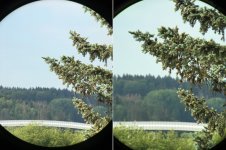Depth of field describes the area in front of and behind the set range that is still perceived by the eye as being sharp. Expanding this area depends on the magnification, distance and accommodation capabilities of the eye.

Left: low depth of field. Only in the set distance, the image appears sharp. Foreground and background are blurred. Right: high depth of field. The sharpness extends from the foreground to the background.
The higher the magnification the lower the depth of field. 10x binoculars must focus more precisely than a 7x one and readjustments have to be made even for minor changes to the observation distance. The depth of field is the “reverse proportional to the square of the magnification“: This means that doubling the magnification reduces the depth of field by a quarter. Within equal conditions, binoculars with 10x magnification have half the depth of field as compared with 7x binoculars.
At short distances and up at close range the depth of field is very low and very precise focusing is required. The greater the observation distance the higher the depth of field. If binoculars are focused at infinity (e.g. the horizon), everything from a distance equaling the “square of the magnification” is focused crisply.
Example:
If you set a pair of binoculars to infinity, a 7× pair delivers a crisp image from about 50 m, a 10× pair from around 100 m. This is the case for older users. For younger users, the focus extends considerably farther into the foreground because their eyes can accommodate better.
Accommodation is the ability of the eye to focus on different distances. This ability decreases with increasing age, i.e. younger people have a clear advantage – they can perceive a much larger depth of field. Older people have to refocus more often. However, really relaxed and longer observation is only possible at the distance set – even for young people. Everything else tires the eye which is noticed at the latest when autofocus binoculars are used.
How the lens elements move mechanically during focusing with single eyepiece focusing or with a center drive has no effect on optical properties and depth of field. Even the prism system (Porro or roof prisms), which only affects image inversion in different ways does not influence the distribution of sharpness – despite many prejudices to the contrary.
All binoculars with the same magnification deliver practically the same depth of field – regardless of the brand, prism, or focusing mechanism.
Another effect that is caused by magnification is image compression, and this can influence the perception of ‘depth’, that is, how much distance is perceived to be between objects in the foreground, the middle distance and far distance. This is not the same as depth of field but it has a related effect on the image.
For example, in the image below, neither the branch in the foreground, or the forest in the background or the photographer taking the photo moved in between taking the photos, but it is clear to see that the apparent distance between the branch and the forest changes.
Higher magnification binoculars reduce this apparent distance while lower magnification binoculars increase it. As a result many kinds of subjects including landscapes can look quite different when viewed through 7× magnification binoculars compared with 10x.

Left: low depth of field. Only in the set distance, the image appears sharp. Foreground and background are blurred. Right: high depth of field. The sharpness extends from the foreground to the background.
The higher the magnification the lower the depth of field. 10x binoculars must focus more precisely than a 7x one and readjustments have to be made even for minor changes to the observation distance. The depth of field is the “reverse proportional to the square of the magnification“: This means that doubling the magnification reduces the depth of field by a quarter. Within equal conditions, binoculars with 10x magnification have half the depth of field as compared with 7x binoculars.
At short distances and up at close range the depth of field is very low and very precise focusing is required. The greater the observation distance the higher the depth of field. If binoculars are focused at infinity (e.g. the horizon), everything from a distance equaling the “square of the magnification” is focused crisply.
Example:
If you set a pair of binoculars to infinity, a 7× pair delivers a crisp image from about 50 m, a 10× pair from around 100 m. This is the case for older users. For younger users, the focus extends considerably farther into the foreground because their eyes can accommodate better.
Accommodation is the ability of the eye to focus on different distances. This ability decreases with increasing age, i.e. younger people have a clear advantage – they can perceive a much larger depth of field. Older people have to refocus more often. However, really relaxed and longer observation is only possible at the distance set – even for young people. Everything else tires the eye which is noticed at the latest when autofocus binoculars are used.
How the lens elements move mechanically during focusing with single eyepiece focusing or with a center drive has no effect on optical properties and depth of field. Even the prism system (Porro or roof prisms), which only affects image inversion in different ways does not influence the distribution of sharpness – despite many prejudices to the contrary.
All binoculars with the same magnification deliver practically the same depth of field – regardless of the brand, prism, or focusing mechanism.
Another effect that is caused by magnification is image compression, and this can influence the perception of ‘depth’, that is, how much distance is perceived to be between objects in the foreground, the middle distance and far distance. This is not the same as depth of field but it has a related effect on the image.
For example, in the image below, neither the branch in the foreground, or the forest in the background or the photographer taking the photo moved in between taking the photos, but it is clear to see that the apparent distance between the branch and the forest changes.
Higher magnification binoculars reduce this apparent distance while lower magnification binoculars increase it. As a result many kinds of subjects including landscapes can look quite different when viewed through 7× magnification binoculars compared with 10x.





